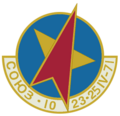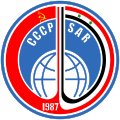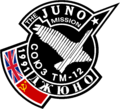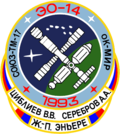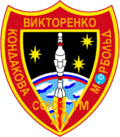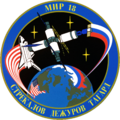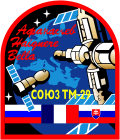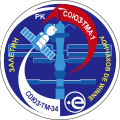Top Qs
Timeline
Chat
Perspective
List of Soyuz missions
From Wikipedia, the free encyclopedia
Remove ads
This is a list of crewed and uncrewed flights of Soyuz series spacecraft.
The Soyuz programme is an ongoing human spaceflight programme which was initiated by the Soviet Union in the early 1960s, originally part of a Moon landing project intended to put a Soviet cosmonaut on the Moon. It is the third Soviet human spaceflight programme after the Vostok and Voskhod programmes. Since the 1990s, as the successor state to the Soviet Union, Russia has continued and expanded the programme, which became part of a multinational collaboration to ensure a permanent human presence in low Earth orbit on the ISS (ISS). Soyuz spacecraft previously visited the Salyut and Mir space stations. Between the retirement of the Space Shuttle in 2011 and the first orbital flight of SpaceX's Crew Dragon in 2019, Soyuz were the only human-rated orbital spacecraft in operation, and the only way to transport crews to the ISS. Russia plans to succeed Soyuz in the 2020s with the Federatsiya/Orel programme, using new reusable capsules launching on Angara rockets, to transport cosmonauts to orbit and to a space station around the Moon.
Remove ads
Crewed mission numbers and spacecraft generations
Summarize
Perspective
Beginning in 1966, the Soyuz programme has sent humans into space on a regular basis for over fifty years. Due to its length, the program has a complex history, which may lead to confusion about its mission numbers. The mission numbering scheme for crewed Soyuz flights is closely related to the generations of spacecraft. Understanding the former is made significantly easier by understanding the latter.
The first era of the Soyuz programme's crewed missions (Soyuz 1-40) used the 7K series of Soyuz craft, which included the first-generation (1.0) Soyuz 7K-OK, a variant (1.5) Soyuz 7K-OKS, the second-generation (2.0) Soyuz 7K-T, and the (2.5) Soyuz 7K-TM variant. Following this first era, successive eras of crewed missions have had mission numbers which were directly tied to the names of craft used:
- The second era of Soyuz T flights used the third-generation (3.0) craft of the same name. Mission numbers were of the form: "Soyuz T-#".
- The third era of Soyuz TM flights used the fourth-generation (4.0) craft of the same name. Mission numbers were of the form: "Soyuz TM-#".
- The fourth era of Soyuz TMA flights used the fifth-generation (5.0) craft of the same name. Mission numbers were of the form: "Soyuz TMA-#".
- The fifth era of Soyuz TMA-M flights used the fifth-generation variant (5.5) craft of the same name. Mission numbers were of the form "Soyuz TMA-##M".
- The sixth and current era of Soyuz MS flights uses the sixth-generation (6.0) craft of the same name. Mission numbers are of the form: "Soyuz MS-##".
Within each given era, a mission number generally reflects the mission's chronological launch order, e.g. Soyuz TMA-12M was the twelfth mission of the TMA-M era, immediately preceded by Soyuz TMA-11M and immediately followed by Soyuz TMA-13M. Although there are exceptions to this (detailed below in the first table), the mission numbering scheme is usually consistent with chronological launch orders. This is in contrast with the mission numbers of the Space Shuttle program, which were tied to specific mission objectives and did not reflect chronological launch orders, e.g. STS-50, the forty-eighth Shuttle mission, was immediately followed by STS-46, the forty-ninth Shuttle mission.
Remove ads
Soyuz 7K (1966–1981)
Summarize
Perspective
The first Soyuz series was the 7K series.
Soyuz 7K-L1
Spacecraft designed for Soviet human circumlunar missions. Missions are included under the Zond programme.
Soyuz 7K-LOK
Spacecraft designed for Soviet human lunar orbital and landing missions.
Remove ads
Soyuz T (1979–1986)
Remove ads
Soyuz TM (1987–2002)
Remove ads
Soyuz TMA (2002–2012)
Remove ads
Soyuz TMA-M (2010–2016)
Remove ads
Soyuz MS (2016–)
Remove ads
See also
Notes
- Aborted mission which nevertheless achieved sub-orbital spaceflight, with the crew surviving.
- Includes five special cases: two fatal missions, Soyuz 1 and Soyuz 11, both of which reached space; Soyuz 19, the Soviet participant in the Apollo-Soyuz Test Project; Soyuz 32, which sent a crew to the Salyut 6 space station and returned to Earth without its crew, and Soyuz 34, which was launched uncrewed and sent to Salyut 6 to provide the crew of Soyuz 32 with a successful return craft.
- Soyuz MS-10 aborted after launch, failing to reach space; crew survived. Included here as a committed launch attempt and a notable historical example.
References
- Wade, Mark. "Encyclopedia Astronautica". Archived from the original on 5 July 2002.
Footnotes
Wikiwand - on
Seamless Wikipedia browsing. On steroids.
Remove ads



